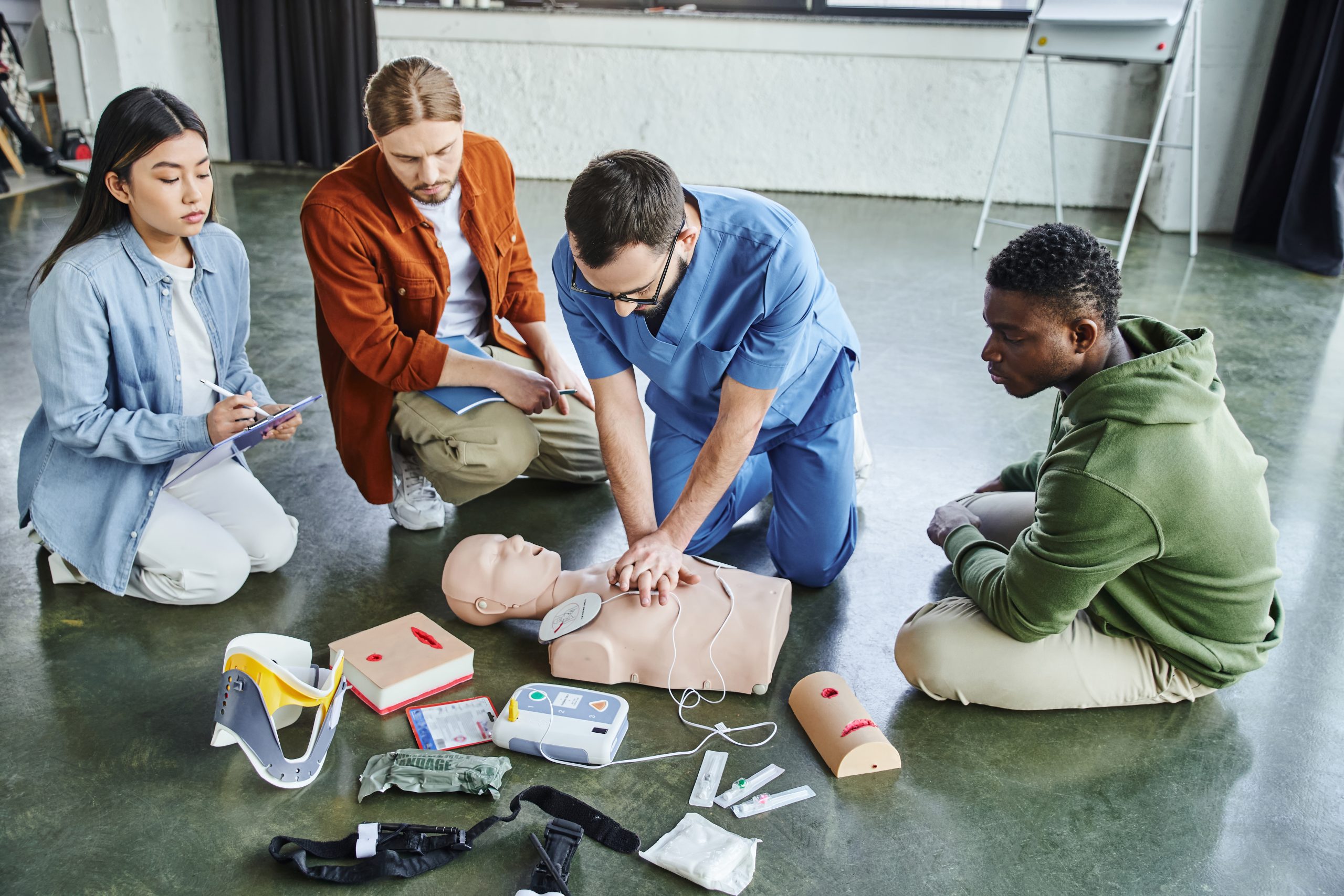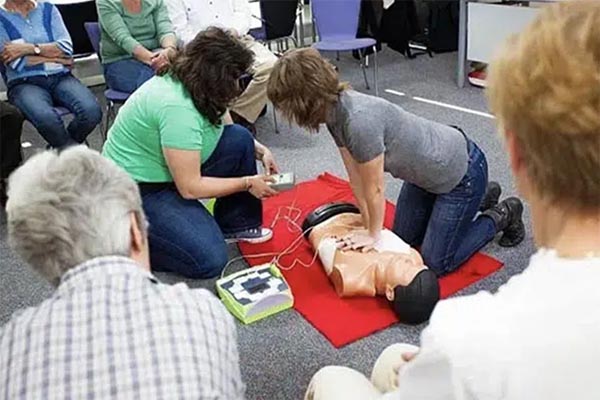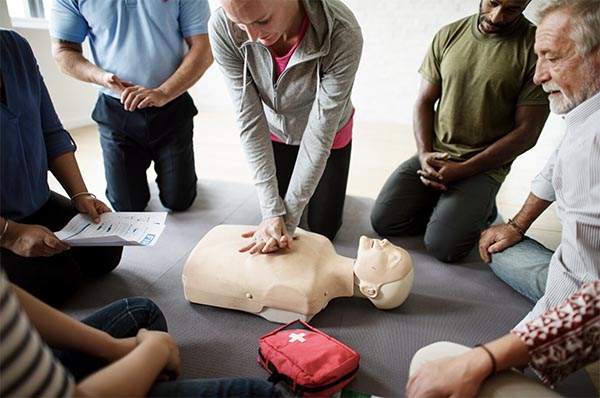
In moments of crisis, clarity is power. Imagine a coworker suddenly slumping over their desk, a loved one choking at dinner, or a stranger collapsing in a parking lot. Would you know what to do? These scenarios are frightening, but with the right knowledge, you can transform from a helpless bystander into a confident first responder.
This guide is your deep dive into the world of CPR and First Aid. We’ll demystify the acronyms, clarify the techniques, and show you why getting certified is one of the most empowering decisions you can ever make.
What is CPR, Really? The Heart of the Matter
CPR stands for Cardiopulmonary Resuscitation. It’s an emergency procedure that can help save a person’s life if their breathing or heart stops.
Think of it this way: your body is a complex machine, and the heart is its engine. When someone goes into sudden cardiac arrest, that engine has stalled. CPR is the manual restart process, keeping critical systems online until professional help can fix the underlying problem.
Cardiac Arrest: An “Electrical” Problem
The most common reason for needing CPR is sudden cardiac arrest. It’s crucial to understand this isn’t the same as a heart attack.
- A heart attack is a “plumbing” problem. A blockage in an artery prevents blood from reaching a part of the heart muscle. The person is usually awake and can describe their symptoms.
- Cardiac arrest is an “electrical” problem. The heart’s electrical system malfunctions, causing it to beat erratically or stop altogether. The person collapses, is unresponsive, and isn’t breathing normally.
A heart attack can sometimes lead to cardiac arrest, but they are distinct events. CPR is the answer for cardiac arrest.

The Mechanics of CPR: C-A-B
Modern CPR, as guided by organizations like the American Heart Association (AHA), follows the C-A-B sequence.
- C for Compressions: This is the most critical part of CPR. By pushing hard and fast in the center of the chest, you are manually squeezing the heart to pump blood to the brain and other vital organs. The target rate is 100 to 120 compressions per minute. (Think of the beat of the song “Stayin’ Alive” by the Bee Gees).
- A for Airway: After performing 30 chest compressions, you need to ensure the person’s airway is open. This is done with a simple head-tilt, chin-lift maneuver, which pulls the tongue away from the back of the throat.
- B for Breathing: With the airway open, you provide two rescue breaths, each lasting about one second, making the chest rise. This delivers oxygen into the lungs, which is then circulated by the next round of compressions.
The cycle of 30 compressions and 2 breaths is repeated until help arrives, an AED becomes available, or the person shows obvious signs of life.
Beyond CPR: The Comprehensive World of First Aid
While CPR is a vital skill for the ultimate emergency, First Aid is the umbrella of care that covers a vast range of injuries and illnesses. It’s the immediate assistance given to any person suffering from either a minor or serious condition.
The goal of first aid is to preserve life, prevent the situation from worsening, and promote recovery until medical professionals take over.
What Does First Aid Cover?
Being trained in first aid prepares you to confidently handle situations like:
- Severe Bleeding: Knowing how to apply direct pressure and use tourniquets can stop life-threatening blood loss.
- Choking: Performing abdominal thrusts (the Heimlich maneuver) can dislodge an object blocking someone’s airway. There are different techniques for adults, children, and infants.
- Burns: Properly assessing the severity of a burn and providing immediate, correct care (like cooling the area) can drastically reduce long-term damage.
- Allergic Reactions (Anaphylaxis): Recognizing the signs of a severe allergic reaction and knowing how to assist someone with their epinephrine auto-injector (like an EpiPen) is a life-saving skill.
- Seizures: Understanding how to keep a person safe during a seizure—clearing the area, protecting their head, and not restraining them—is crucial.
- Sprains and Fractures: Knowing how to properly immobilize an injured limb can prevent further injury and reduce pain.
- Strokes: Recognizing the signs of a stroke using the B.E. F.A.S.T. acronym (Balance, Eyes, Face, Arms, Speech, Time) ensures the person gets to a hospital as quickly as possible, which is critical for their outcome.
First Aid training gives you a versatile toolkit to handle the emergencies you are far more likely to encounter on a day-to-day basis.
The Unsung Hero: Understanding the AED
In any discussion about cardiac arrest, you’ll hear about the AED, or Automated External Defibrillator. These portable, lightweight devices are becoming common in public spaces like airports, gyms, and offices for one simple reason: they save lives.
An AED is a sophisticated yet easy-to-use device that analyzes the heart’s rhythm. If it detects a shockable rhythm (like ventricular fibrillation), it advises and delivers an electrical shock. This shock, called defibrillation, briefly stops the heart, giving it a chance to reset to a normal rhythm.
Using an AED alongside high-quality CPR can increase a person’s chance of survival from cardiac arrest by over 70%. The device gives clear, calm voice prompts, walking you through every step, from placing the pads on the bare chest to delivering a shock. You cannot accidentally shock someone who doesn’t need it; the device will only advise a shock if its analysis confirms a life-threatening arrhythmia.
CPR vs. First Aid: A Clear Comparison
While they are related, it’s helpful to see their differences side-by-side.
- Focus:
- CPR: Singularly focused on victims of cardiac arrest who are unresponsive and not breathing.
- First Aid: Broadly focused on a wide variety of injuries and illnesses, from minor cuts to major trauma.
- When to Use:
- CPR: Used only when the heart has stopped beating.
- First Aid: Used in any situation requiring immediate medical care before professionals arrive.
- Core Skills:
- CPR: Chest compressions and rescue breaths.
- First Aid: Bleeding control, wound care, choking relief, burn management, splinting, recognizing signs of stroke/heart attack, and much more.
Think of it this way: a combined CPR and First Aid course prepares you for nearly any medical emergency you might face.
Why Certification is Non-Negotiable
Watching a video or reading an article is a great start, but it’s no substitute for hands-on, professional training. Getting certified is essential for several reasons.
- Develops Muscle Memory: In a real emergency, adrenaline floods your system. You won’t have time to think. Certification courses use manikins to let you practice the physical skills of CPR and First Aid until they become second nature.
- Builds True Confidence: There’s a huge difference between knowing what to do and having the confidence to actually do it. A certified training course, led by an experienced instructor, empowers you to act decisively.
- Provides Legal Protection: Good Samaritan laws exist in all 50 states to protect bystanders who offer reasonable assistance to those in need. Being certified demonstrates you’ve been trained to an accepted standard, strengthening these protections.
- Keeps You Updated: Medical guidelines evolve. Certification courses, which require renewal every two years, ensure your knowledge is based on the latest science and best practices.

The Chain of Survival: Your Role in the System
Saving a life from cardiac arrest isn’t a single action; it’s a series of coordinated events known as the Chain of Survival. As a bystander, you are the first and most critical link.
- Immediate Recognition and Activation of EMS: Recognizing someone is in cardiac arrest and calling 911 immediately.
- Early CPR: Starting high-quality chest compressions right away to keep blood flowing.
- Rapid Defibrillation: Using an AED as soon as one is available to shock the heart back into a normal rhythm.
- Advanced Resuscitation: The care provided by paramedics and EMTs once they arrive.
- Post-Cardiac Arrest Care: The specialized treatment the patient receives in the hospital.
- Recovery: The long-term support, including physical and emotional rehabilitation.
Without the first three links, all of which can be performed by a trained bystander—the chances of survival plummet. You are the bridge to life.
Conclusion: From Bystander to Lifesaver
Knowledge is the first step, but action is what saves lives. Understanding the mechanics of CPR, the breadth of first aid, and the power of an AED is transformative. It changes your perspective from “What if something happens?” to “I know what to do when something happens.”
The skills are straightforward, the training is accessible, and the impact is immeasurable. You have the potential to be the person who makes the difference for a family member, a colleague, or a complete stranger. Don’t wait for an emergency to wish you had been prepared.
Are you ready to gain the skills and confidence to act when it matters most? Don’t just be a bystander. Be a lifesaver. Contact CPR Classes Near Me today to find a certification course and take the first step toward mastering these essential life-saving skills.
Frequently Asked Questions (FAQ)
Q1: What is the main difference between a heart attack and cardiac arrest?
A1: The main difference lies in the underlying problem. A heart attack is a “plumbing” issue where a blocked artery stops blood flow to the heart muscle, causing tissue to die. The person is usually conscious. Cardiac arrest is an “electrical” issue where the heart’s electrical system malfunctions, causing it to stop beating effectively. The person is unconscious and not breathing. A heart attack can lead to cardiac arrest, but they are not the same thing.
Q2: Am I required to give rescue breaths during CPR?
A2: For trained responders, the official recommendation is to perform conventional CPR with a cycle of 30 compressions and 2 rescue breaths. However, if you are untrained or unwilling to perform rescue breaths, you can perform Hands-Only CPR. Hands-Only CPR consists of providing continuous, fast, and hard chest compressions (100-120 per minute) until help arrives. It has been shown to be very effective and is much better than doing nothing at all.
Q3: Can I be sued for performing CPR or First Aid?
A3: All 50 states have Good Samaritan laws in place to protect individuals who voluntarily provide emergency assistance to an injured or ill person in good faith. As long as you act reasonably, within the scope of your training, and do not receive payment for your actions, these laws are designed to protect you from liability. Getting certified is one of the best ways to ensure you are acting according to established standards.
Q4: How long does a CPR and First Aid certification last?
A4: Standard CPR, AED, and First Aid certifications are valid for two years. This ensures that certified individuals stay up-to-date with any changes in protocols and have a chance to refresh their hands-on skills, which can diminish over time. To remain certified, you must complete a renewal course before your current certification expires.
Q5: Who should get certified in CPR and First Aid?
A5: Everyone! While certain professions require it (like healthcare providers, teachers, childcare workers, and personal trainers), these skills are valuable for all individuals. Parents, grandparents, office workers, coaches, and anyone who wants to be prepared to help in an emergency should get certified. A medical crisis can happen to anyone, anywhere, at any time.

Leave a Reply